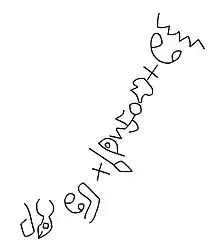
The Wadi el-Hol inscriptions are two rock inscriptions which appear to show the oldest examples of phonetic alphabetic writing discovered to date.[1][2]
Wadi el-Hol (where Wadi means valley in Arabic) is a valley on the Farshut Road, north-west of Luxor on the Qena Bend, situated on the west bank of the river Nile in Egypt.[3]
History
In 1993, American egyptologists Deborah Darnell and her then husband John Darnell found letters in two single-line rock inscriptions carved into limestone cliffs in the Wadi el-Hol valley. They returned to the site for several seasons through the 1990s to further study the inscriptions. In 1999, they finally published their research, concluding that they had found the earliest surviving alphabet, dating back to around 1800 to 1900 BCE.[4][5] In particular, the inscriptions appear to resemble the Proto-Sinaitic script from Serabit el-Khadem.
See also
References
- ↑ Goldwasser, Orly (Mar–Apr 2010). "How the Alphabet Was Born from Hieroglyphs". Biblical Archaeology Review. Washington, DC: Biblical Archaeology Society. 36 (1). ISSN 0098-9444. Retrieved 6 Nov 2011.
- ↑ LeBlanc, P.D. (2017). Deciphering the Proto-Sinaitic Script: Making Sense of the Wadi el-Hol and Serabit el-Khadim Early Alphabetic Inscriptions. Unknown Publisher. ISBN 978-0-9952844-0-1. Retrieved 2023-04-30.
11
- ↑ Baker, Dorie (13 December 1999). "Finding sheds new light on the alphabet's origins". Yale Bulletin and Calendar.
- ↑ "Oldest alphabet found in Egypt". BBC. 15 November 1999.
- ↑ WILFORD, John Noble (13 November 1999). "Discovery of Egyptian Inscriptions Indicates an Earlier Date for Origin of the Alphabet". The New York Times.
Further reading
- Darnell, John Coleman; Dobbs-Allsopp, F. W.; Lundberg, Marilyn J.; McCarter, P. Kyle; Zuckerman, Bruce (2005). "Two Early Alphabetic Inscriptions from the Wadi el-Hôl". The Annual of the American Schools of Oriental Research. 59: 63, 65, 67–71, 73–113, 115–124. JSTOR 3768583.